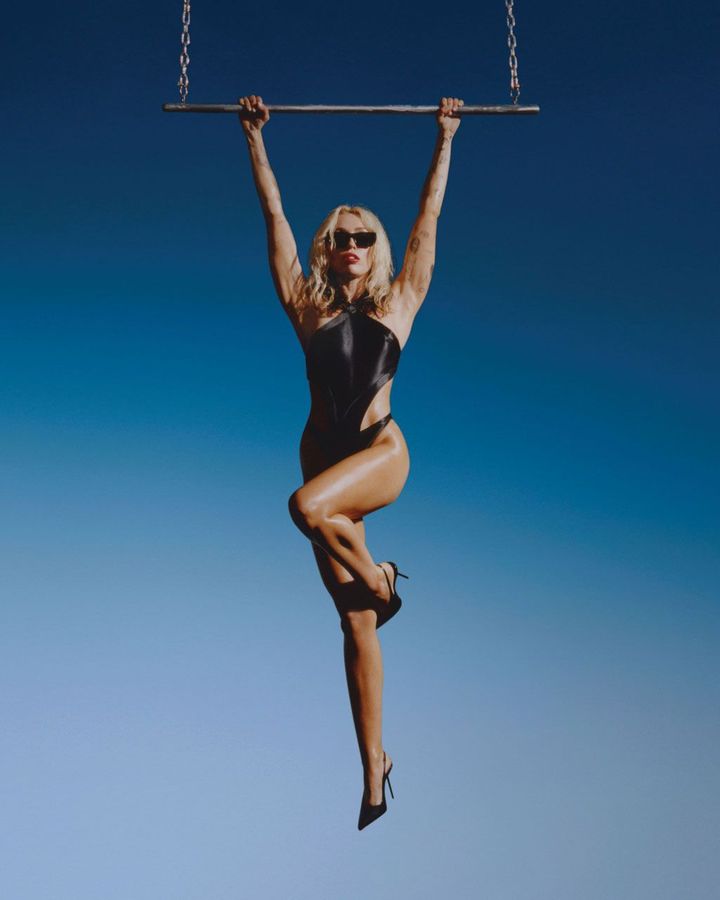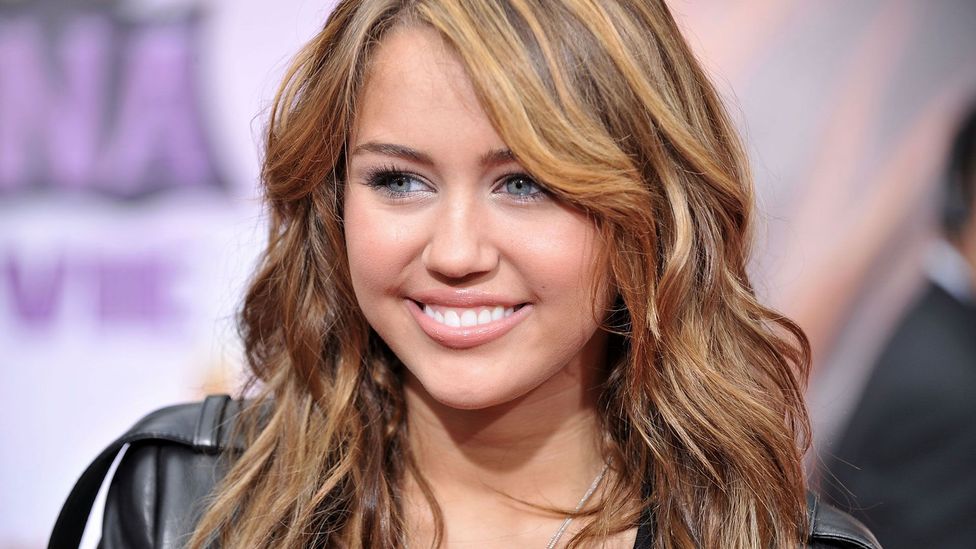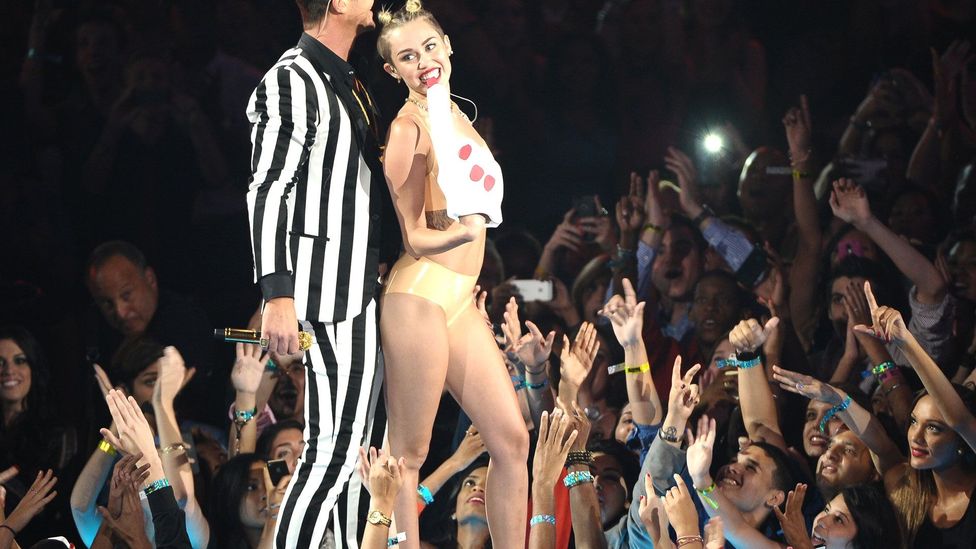Across decades of pop music, numerous performers have been lauded for their chameleon-like quality – a preternatural ability to switch up their image and sound without sacrificing their artistic identity. David Bowie and Madonna are the two most famous who spring to mind. But Miley Cyrus has baked shapeshifting into her personal brand in a particularly 21st-Century fashion. The consummate modern pop star, she has taken advantage of blurred genre boundaries at a time when eclectic Spotify playlists hold more sway with listeners than traditional (and generally more genre-prescriptive) radio playlists.
More like this:
– How Shania Twain became a Gen Z icon
– Is it time to reconsider Britney’s legacy?
– Pop’s most underestimated icon
Since Cyrus launched her recording career 17 years ago, when she played a fictional pop star in the hit Disney series Hannah Montana, she has released everything from peppy pop-rock to risqué R&B, and reflective folk-pop to spangly country-disco. Now, the 30-year-old singer, actress and cultural lightning rod is enjoying one of her biggest ever hits with Flowers, a breezy paean to self-love that contains echoes of Gloria Gaynor’s I Will Survive. Cyrus and subtlety haven’t always gone hand in hand – she quite literally rode a wrecking ball in the video for her 2013 chart-topper Wrecking Ball – but Flowers is notable for its vocal and musical restraint. “I can love me better than you can,” she sings on the wistful chorus of this sun-dappled disco track, which has topped the Billboard Hot 100 for the last seven weeks. It is the lead single from Endless Summer Vacation, her eighth studio album, which is released today and poised to usher in another imperial phase for the singer. River, the album’s brilliant second single, is another instant Cyrus classic – not least because it seems cut from the same sonic cloth as Midnight Sky, the singer’s Stevie Nicks-inspired hit from 2020.

New album Endless Summer Vacation’s album cover shows her hanging from a trapeze – a typically bold image (Credit: Columbia Records)
Flowers’ message of self-love is delivered with shimmering sincerity, but Cyrus has also displayed a rare willingness to play with her own image. In a 2019 episode of Black Mirror, she portrayed a fictional teen-pop star called Ashley O, a character that winked at Cyrus’s early alter ego, Hannah Montana, right down to a less than convincing wig. In her guise as “Ashley O”, she even reimagined Nine Inch Nails’ industrial rock banger Head Like a Hole as a sunny club track called On a Roll: a brilliantly witty moment. Hugh McIntyre, a music journalist with Forbes, believes “it is accurate to call Cyrus a shapeshifter or a chameleon” because “she has shown, time and time again, that she can deliver high-quality music that performs well in a variety of genres”. McIntyre notes that though Cyrus has not “tackled everything” musically, “she has done rock and pop and electronic music, and even leaned into country and hip-hop from time to time”. Not all of Cyrus’s projects have been blockbusters: after releasing 2019’s She Is Coming, a trap-influenced EP that was supposed to be the first in a trilogy, she recalibrated and re-emerged with the following year’s rock-leaning album, Plastic Hearts. But at the same time, none has been an outright flop. “It has all gone fairly well,” McIntyre says of Cyrus’s genre-hopping, “and that’s not something that everyone can do.”
Endless Summer Vacation is the latest example of Cyrus’s flair for reinvention. Here, she offers candid insights into the breakdown of a romantic relationship while offering musical nods to genres she has previously excelled in: country on Thousand Miles, synth-pop on Violet Chemistry, psychedelic rock on Rose Colored Lenses. “You’re not even willing to look at your part,” she sings on the alt-rock-flavoured Jaded, a song addressed an unnamed ex. “You just jump in the car and head down to thе bar ’til you’re blurry.” She describes the record as her “love letter to LA”, which could almost make it sound unassuming, but Cyrus has not lost her fondness for a grand gesture. The album’s cover art shows her confidently hanging from a trapeze; according to a record label press release, this image was “fully executed by Miley without visual effects”. “I love the fact that Miley is so consistent in being her authentic self,” says ABISHA, a British singer-songwriter who hails Cyrus as an influence. “She’s not afraid to push boundaries or be slightly outrageous and I find that really iconic.” The album also features collaborations with chart-topping pop alchemist Sia and Grammy-winning Americana and country singer Brandi Carlile, underlining Cyrus’s high standing among her peers: in the past, she has recorded with everyone from psychedelic rock band The Flaming Lips to country icon Dolly Parton, who happens to be her godmother.
An old showbiz hand
Though only 30 years of age, Cyrus is already a seasoned industry veteran. The Nashville-born daughter of popular country singer Billy Ray Cyrus and music manager Tish Finley, she launched her performing career in 2001 with an uncredited guest appearance in Doc, a medical drama series starring her father. Five years later, when she was 13, Cyrus became a global teen idol with her starring role in Hannah Montana. This wholesome sitcom, which ran for four seasons and a spin-off film, cast Cyrus as Miley Stewart, a seemingly ordinary girl who lives a double life as tween-pop icon Hannah Montana. The show’s ingenious premise gave Cyrus, a strong singer and natural comedian, ample opportunity to project both down-to-earth relatability and a budding superstar’s flashy charisma. She grabbed the baton and ran with it, releasing three Billboard chart-topping albums in her guise as Hannah.
But because she rose to prominence playing a fictional singer, Cyrus had to evolve – and think outside of the box – right from the beginning. Transitioning from Hannah Montana to Miley Cyrus without alienating her Disney Channel fanbase was, in effect, her first musical evolution. At first, she proceeded with caution: her 2007 debut solo LP Meet Miley Cyrus was released as a double album with the soundtrack to season two of the TV show. See You Again, a standout single from the Meet Miley Cyrus side, offered a glimpse of the pop-savvy but idiosyncratic artist she would blossom into. Describing an embarrassing encounter with someone she is attracted to – “You asked what’s wrong with me? My best friend Lesley said, ‘Oh, she’s just being Miley'” – the song has ear-snagging lyrics that pointed to Cyrus having her own quirky songwriting vernacular.
Cyrus didn’t say goodbye to Hannah Montana until the show’s season finale in January 2011, but by this point, she had established herself as a viable pop star in her own right. She had also demonstrated a healthy amount of musical range by scoring hits with a pop-punk nugget (2008’s 7 Things), a country-flavoured power ballad (2009’s The Climb) and a glossy midtempo pop song (2009’s Party in the USA). The latter was co-written by British singer Jessie J and originally slated to appear on her debut album, but, when it was passed onto Cyrus instead, the lyrics about feeling “nervous” and “homesick” after touching down in glamorous Los Angeles cleverly fed into her persona as an ambitious Nashville girl trying to make it in the big smoke. In reality, though, she had actually relocated to LA around four years earlier.

Cyrus shot to fame in her early teens with her starring role in Disney series Hannah Montana (Credit: Getty Images)
More than 13 years after it peaked at number two on the Billboard Hot 100, Party in the USA remains Cyrus’s most streamed song with 1.135 billion Spotify plays. But with the benefit of hindsight, her 2010 single Can’t Be Tamed feels more prescient. “I wanna fly, I wanna drive, I wanna go, I wanna be a part of something I don’t know,” she sings on this infectious electro-pop stomper. Though the song is ostensibly addressed to a prospective partner, it is easy to read these lyrics as an expression of Cyrus’s restless creative spirit. In a 2020 interview on The Tonight Show Starring Jimmy Fallon, she confirmed that Can’t Be Tamed was effectively a harbinger of things to come, saying: “I was already telling y’all that something was about to happen, that I wasn’t Hannah Montana.”
When she performed We Can’t Stop with Robin Thicke at the 2013 MTV Video Music Awards (VMAs), Cyrus obliterated any last vestiges of her once-wholesome image. After she twerked against Thicke while pointing a foam finger at intimate parts of her body, the foam finger’s inventor Steve Chmelar said he was disappointed by the aberrant use of such a national icon. Cyrus became a polarising presence during the Bangerz campaign, but McIntyre perceives any negative press coverage as collateral damage. “It was Miley’s moment to step out of the Disney spotlight and try something edgier and more adult, and that is always going to be received with some caution,” he says. McIntyre also points out that Cyrus was canny enough to back up her new, grown-up persona with a pair of undeniable singles. “We Can’t Stop and Wrecking Ball really feel like they were crafted to become huge, platinum-selling hits, and that’s exactly what they became,” he says.
Music journalist El Hunt believes Bangerz caused a massive splash partly because it was such a “marked departure” for Cyrus, but also because it sparked “the predictable and empty outrage that always seems to follow female musicians in particular when they sing about sexual empowerment”. In 2019, on the album’s sixth anniversary, Cyrus seemed to acknowledge this controversy in an Instagram post, writing: “Happy 6-year anniversary #Bangerz!!!! Here’s to 6 more years of pissing people off!” However, it is important to acknowledge that Cyrus’s Bangerz era also attracted a more valid strain of criticism – namely, that she had cherry-picked aspects of black culture to accentuate her new, edgier image. She raised eyebrows in particular for her exuberant embrace of twerking, a dance form that originated on the black-led bounce scene in 1980s New Orleans, and for surrounding herself in music videos with women of colour. “It’s mind-boggling to me that there was even a controversy around me having black dancers,” Cyrus protested to Billboard when asked about the latter in 2017. “That became a thing, where people said I was taking advantage of black culture, and with Mike [Will Made It] … that wasn’t true. Those were the dancers I liked!”
However, Hunt believes this criticism was exacerbated by Cyrus’s “incredibly rapid departure from [the Bangerz] sound which was heavily influenced by hip-hop and black culture”. In fact, Cyrus followed her breakthrough album with a dazzling and disarming musical volte-face: 2015’s Miley Cyrus & Her Dead Petz. This sprawling and experimental fifth album came out of the blue when she announced it was instantly available to stream online – for free, then a novelty – while hosting that year’s VMAs. Partly crafted with psychedelic rock band The Flaming Lips, it featured 23 offbeat and flagrantly un-radio-friendly tracks with trippy titles such as Miley Tibetan Bowlzzz, Fweaky and Something About Space Dude. At the time, even her record label was blindsided. “They had never heard the record until it was done,” Cyrus told The New York Times.
Even after her pivot away from hip-hop-flavoured pop, rumblings about the singer’s potentially problematic relationship with black culture did not entirely die down. While promoting her sixth album Younger Now, a relatively restrained collection of folk and country tunes that was a long way from hip-hop, she expressed an admiration for Kendrick Lamar’s latest rap banger Humble while in the process criticising the genre’s content as a whole. Lyrics that she perceived as misogynistic had, Cyrus told Billboard, “pushed me out of the hip-hop scene a little”.

Cyrus’ performance with Robin Thicke at the 2013 MTV Video Music Awards was one of the most talked about awards show moments of all time (Credit: Getty Images)
Many hip-hop fans were incensed, pointing out that Cyrus had benefited from the trappings of their culture when it suited her, then dropped them as soon as she wanted to switch musical direction. In 2019, Cyrus finally apologised for her misguided remarks in a comment posted under a YouTube video titled Miley Cyrus Is My Problematic Fav… Sorry. “I own the fact that saying… ‘this pushed me out of the hip-hop scene a little’ was insensitive as it is a privilege to have the ability to dip in and out of ‘the scene,” Cyrus wrote in response to the video created by YouTuber Kenya Wilson. She also said she was “deeply sorry for the disconnect my words caused”.
During the same year, Cyrus returned to hip-hop-infused pop with She Is Coming, a well-received EP featuring collaborations with Wu-Tang Clan rapper Ghostface Killah, singer-rapper Swae Lee and drag icon RuPaul. Teaming with the latter for a sassy track called Cattitude underscored Cyrus’s status as an LGBTQ role model; in past interviews, she has identified as pansexual and a “queer woman”. “I love her [sexual] fluidity, her queerness and how she is always unapologetically herself,” says ABISHA. Cyrus has also shown her support for this community by launching The Happy Hippie Foundation, a nonprofit that aims “to rally young people to fight injustice facing homeless youth, LGBTQ youth and other vulnerable populations”. Then at the 2019 Glastonbury festival, Cyrus proved she could pull together the disparate strands of her career with a wildly entertaining set peppered with clever cover versions. “She treated that slot like a rock headline show and threw herself into covering everything from Metallica to the original Nine Inch Nails song that inspired her Black Mirror track On a Roll,” Hunt says.
Cyrus followed her triumphant Glastonbury performance by honing her rock chops on 2020’s retro-leaning Plastic Hearts album, for which she duetted with two icons of the genre: Joan Jett and Billy Idol. She also kept one foot in pop’s present by scoring a zingy hit single, Prisoner, with fellow contemporary hitmaker Dua Lipa. So, as she enters a new era with Endless Summer Vacation, an album that features an intriguingly trippy psychedelic track called Handstand that Cyrus co-wrote with experimental film director Harmony Korine, fans already know to expect the unexpected. As she told us back in 2020, she is an artist who “can’t be tamed”.
Cyrus’s successful shapeshifting reflects not just her own musical versatility, but also the unusually fluid musical era that she is navigating. “Even just a couple of years ago, it might have been [seen as] a bit strange for a big star who is known for one style of music to put out something in another style. But these days, it’s pretty commonplace,” says McIntyre. Still, he also believes that Cyrus can ride the genre-blurring wave so confidently because she has developed a genuinely distinctive voice. “We recognise her way of writing, whether [she is singing] a rock song, pop song or something else,” he says. It would be a little pat to suggest that every pivot she makes can be explained by quoting See You Again’s famous lyric: “She’s just being Miley.” However, 16 years after she branched out from Hannah Montana, there is no denying that Cyrus has built a formidable identity as a true musical chameleon. Whatever lane she decides to drive down next, people will be paying attention.